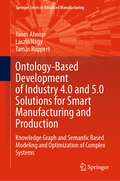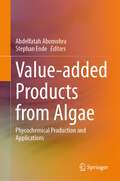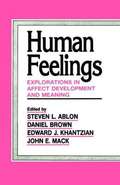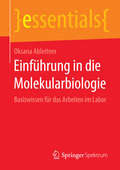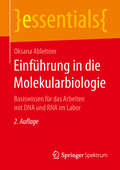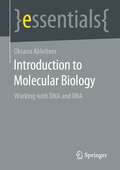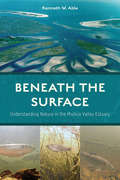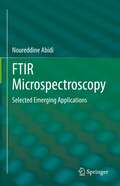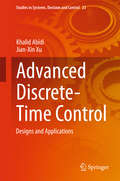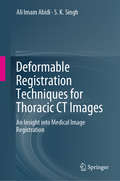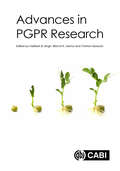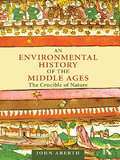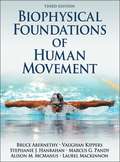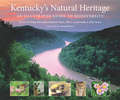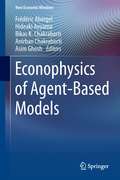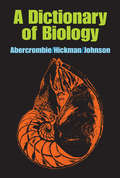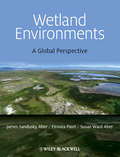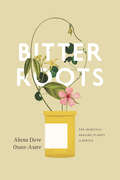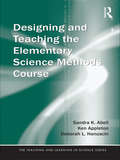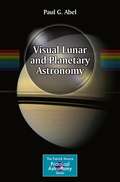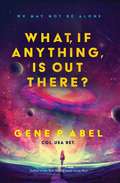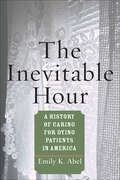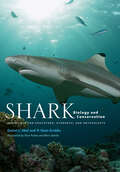- Table View
- List View
Ontology-Based Development of Industry 4.0 and 5.0 Solutions for Smart Manufacturing and Production: Knowledge Graph and Semantic Based Modeling and Optimization of Complex Systems (Springer Series in Advanced Manufacturing)
by János Abonyi László Nagy Tamás RuppertThis book presents a comprehensive framework for developing Industry 4.0 and 5.0 solutions through the use of ontology modeling and graph-based optimization techniques. With effective information management being critical to successful manufacturing processes, this book emphasizes the importance of adequate modeling and systematic analysis of interacting elements in the era of smart manufacturing. The book provides an extensive overview of semantic technologies and their potential to integrate with existing industrial standards, planning, and execution systems to provide efficient data processing and analysis. It also investigates the design of Industry 5.0 solutions and the need for problem-specific descriptions of production processes, operator skills and states, and sensor monitoring in intelligent spaces. The book proposes that ontology-based data can efficiently represent enterprise and manufacturing datasets. The book is divided into two parts: modeling and optimization. The semantic modeling part provides an overview of ontologies and knowledge graphs that can be used to create Industry 4.0 and 5.0 applications, with two detailed applications presented on a reproducible industrial case study. The optimization part of the book focuses on network science-based process optimization and presents various detailed applications, such as graph-based analytics, assembly line balancing, and community detection. The book is based on six key points: the need for horizontal and vertical integration in modern industry; the potential benefits of integrating semantic technologies into ERP and MES systems; the importance of optimization methods in Industry 4.0 and 5.0 concepts; the need to process large amounts of data while ensuring interoperability and re-usability factors; the potential for digital twin models to model smart factories, including big data access; and the need to integrate human factors in CPSs and provide adequate methods to facilitate collaboration and support shop floor workers.
Value-added Products from Algae: Phycochemical Production and Applications
by Abdelfatah Abomohra Stephan EndeThis book provides a comprehensive overview of value-added products from algae, presenting the fundamentals of algal cultivation, metabolism, harvest, and cellular pathways of phycochemicals biosynthesis. It offers sufficient details for both experts and non-experts to grasp the recent progress in this field. The book also discusses new phycochemicals and advancements in technology development, from separation to scale-up commercialization. Divided into 18 chapters, the book begins with an introduction to the value of algae as a renewable resource, followed by an authoritative overview of topics such as algae cultivation systems, harvesting techniques, phycochemical analysis, artificial intelligence in phytochemical recognition, and bioprocess engineering. Additional chapters cover various aspects of algal biotechnology, including biorefinery technology, biofuel-integrated routes, and the use of wastewater for algal growth. The book also explores high throughput screening methods for microalgae-based phycochemicals and examines the catalytic processes involved in algal bioprocessing. Cutting-edge topics such as omics approaches for algal applications, algal-based biopolymers, diatom nanostructured biosilica, and the potential of seaweeds in methane emission mitigation, are also explored. In this book, readers will discover the recent technological applications of algae in aquaculture and will find a case study on the functional food potential of Spirulina. Recognizing the importance of legislation and biosecurity in the field, the last chapter of the book addresses the regulatory frameworks and biosecurity measures necessary for the safe and sustainable development of algal biotechnology. Given its breadth, the book is a valuable resource for scholars, researchers and professionals interested in algal biotechnology, sustainability, biomass conversion, and new algal products from any perspective.
Dinosaurs: Over 100 Questions and Answers to Things You Want to Know
by Dan Abnett Nik VincentDid the dinosaurs have armor? Were dinosaurs good parents? Why did the dinosaurs become extinct? Dinosaurs How big were the dinosaurs? Where in the world did the dinosaurs live? You'll find the answers to these and over 100 other intriguing questions inside this beautifully illustrated book.
Human Feelings: Explorations in Affect Development and Meaning
by Steven L. Ablon Daniel Brown Edward J. Khantzian John E. MackDwelling on the importance of emotions in our life, the author through Harvard Affect Study Group has brought together people with different kinds of training to share a passionate interest in the study of affect.
Einführung in die Molekularbiologie: Basiswissen für das Arbeiten im Labor (essentials)
by Oksana AbleitnerOksana Ableitner bietet eine praxisnahe, klar strukturierte und gut verständliche Einführung in komplizierte Definitionen und Strukturen aus der Chemie und Molekularbiologie für die Laborarbeit. Die Autorin lässt sich dabei von ihrer Erfahrung im Umgang mit Studierenden leiten und nutzt viele Abbildungen, um abstraktes Wissen zu visualisieren. Das Verständnis für diese Materie ist eine essentielle Grundlage für Arbeiten im molekularbiologischen Labor, um ein qualitativ gutes Ergebnis zu sichern. Für die verantwortungsvollen Tätigkeiten in der Anwendung - wie bei der Genforschung oder Bestimmung diverser Krankheiten - ist es erlässlich, sicher im Umgang mit den Grundlagen dieser sensitiven, schnellen und spezifischen Analysemethoden zu sein.
Einführung in die Molekularbiologie: Basiswissen für das Arbeiten mit DNA und RNA im Labor (essentials)
by Oksana AbleitnerOksana Ableitner bietet eine praxisnahe, klar strukturierte und gut verständliche Einführung in komplizierte Definitionen und Strukturen aus der Chemie und Molekularbiologie für die Arbeit im molekularbiologischen Labor. Die Autorin lässt sich dabei von ihrer Erfahrung im Umgang mit Studierenden leiten und nutzt viele Abbildungen, um abstraktes Wissen zu visualisieren. Das Verständnis für diese Materie ist eine essentielle Grundlage für erfolgreiches Arbeiten mit DNA und RNA, um ein qualitativ gutes Ergebnis zu sichern. Für die verantwortungsvollen Tätigkeiten in der Anwendung – wie bei der Genforschung oder Bestimmung diverser Krankheitserreger – ist es unerlässlich, sicher im Umgang mit den Grundlagen dieser sensitiven, schnellen und spezifischen Analysemethoden zu sein.
Introduction to Molecular Biology: Working with DNA and RNA (essentials)
by Oksana AbleitnerOksana Ableitner offers a practical, clearly structured and easy to understand introduction to complicated definitions and structures in chemistry and molecular biology for work in the molecular biology laboratory. The author is guided by her experience in working with students and uses many illustrations to visualize abstract knowledge. An understanding of this matter is an essential basis for successful work with DNA and RNA in order to ensure high quality results. For responsible activities in application - such as genetic research or the determination of various pathogens - it is essential to be confident in dealing with the basics of these sensitive, fast and specific analytical methods.This Springer essential is a translation of the original German 2nd edition essentials, Einführung in die Molekularbiologie by Oksana Ableitner, published by Springer Fachmedien Wiesbaden GmbH, part of Springer Nature in 2018. The translation was done with the help of artificial intelligence (machine translation by the serviceDeepL.com). A subsequent human revision was done primarily in terms of content, so that the book will read stylistically differently from a conventional translation. Springer Nature works continuously to further the development of tools for the production of books and on the related technologies to support the authors.
Beneath the Surface: Understanding Nature in the Mullica Valley Estuary
by Kenneth W. AbleThe Mullica Valley estuary and its watershed, formed over the last 10,000 years, are among the cleanest estuaries along the east coast of the United States. This 365,000-acre ecosystem benefits from a combination of protected watershed, low human population density, and general lack of extensive development. In Beneath the Surface, marine scientist Ken Able helps the reader penetrate the surface and gain insights into the kinds of habitats, animals, and plants that live there. Readers will gain a better understanding of the importance of these shallow waters; how the amount of salt in the water determines where animals and plants are found in estuaries; the day-night, seasonal, and annual variation in their occurrence; and how change is occurring as the result of climate variation. Throughout the book are insightful sidebars telling intimate stories of where various animals came from and where they are going as they travel through the estuary on their way to and from other portions of the east coast. Beneath the Surface emphasizes the kinds and importance of the animals and plants that live beneath the surface of this unique ecosystem.
FTIR Microspectroscopy: Selected Emerging Applications
by Noureddine AbidiFourier Transform Infrared microspectroscopy (FTIR) was first developed by William Coblentz in 1905 for analytical purposes. It has been established as a powerful analytical method to analyze a wide range of materials. The most convenient way to analyze the molecular structure was to prepare KBr pellets with small amount of chemical species. Currently, the development of the Universal Attenuated Total Reflectance (UATR) allows the use of ZnSe-Diamond crystal to acquire FTIR spectra directly from the sample with no special preparation. These traditional FTIR analyses have been made with devices capable of performing single measurements, thus, providing a single IR spectrum of the sample. Recent major technological development in FTIR instrumentation was development of microscopes and imaging systems. These devices are now capable of imaging larger sample area, providing not only spectroscopic information but also spatial distributional information. In addition, the development of Focal Point Array (FPA) has made FTIR imaging an emerging area of chemical imaging research. The aim of this book is to summarize in a single document the research work that is being performed using UATR and IR imaging in selected emerging applications in plant materials and biological samples. This book provides the readers new knowledge, updates information, emerging applications, and understanding of the potential use of FTIR Microspectroscopy.
Advanced Discrete-Time Control: Designs and Applications (Studies in Systems, Decision and Control #23)
by Khalid Abidi Jian-Xin XuThis book covers a wide spectrum of systems such as linear and nonlinear multivariable systems as well as control problems such as disturbance, uncertainty and time-delays. The purpose of this book is to provide researchers and practitioners a manual for the design and application of advanced discrete-time controllers. The book presents six different control approaches depending on the type of system and control problem. The first and second approaches are based on Sliding Mode control (SMC) theory and are intended for linear systems with exogenous disturbances. The third and fourth approaches are based on adaptive control theory and are aimed at linear/nonlinear systems with periodically varying parametric uncertainty or systems with input delay. The fifth approach is based on Iterative learning control (ILC) theory and is aimed at uncertain linear/nonlinear systems with repeatable tasks and the final approach is based on fuzzy logic control (FLC) and is intended for highly uncertain systems with heuristic control knowledge. Detailed numerical examples are provided in each chapter to illustrate the design procedure for each control method. A number of practical control applications are also presented to show the problem solving process and effectiveness with the advanced discrete-time control approaches introduced in this book.
Deformable Registration Techniques for Thoracic CT Images: An Insight into Medical Image Registration
by Ali Imam Abidi S.K. SinghThis book focuses on novel approaches for thoracic computed tomography (CT) image registration and determination of respiratory motion models in a range of patient scenarios. It discusses the use of image registration processes to remove the inconsistencies between medical images acquired using different devices. In the context of comparative research and medical analysis, these methods are of immense value in image registration procedures, not just for thoracic CT images, but for all types of medical images in multiple modalities, and also in establishing a mean respiration motion model. Combined with advanced techniques, the methods proposed have the potential to advance the field of computer vision and help improve existing methods. The book is a valuable resource for those in the scientific community involved in modeling respiratory motion for a large number of people.
Advances in PGPR Research
by P. C. Abhilash Betina Cecilia Agaras Gautam Anand Laith K. Al-Ani Fabiola Padilla Arizmendi Fatima Berenice Salazar-Badillo Mansi Bakshi E. J. Bedmar Adrien Biessy Virendra S. Bisaria Kartikay Bisen Marieta Marin Bruzos Jesús Salvador López-Bucio Jose López-Bucio Randy Ortiz-Castro Jorge Armando Mauricio-Castillo Vasvi Chaudhry Niladri Chaudhry Manoj Kumar Chitara Pooja Choudhary Manish Kumar Dubey Pradeep Kumar Dubey Rama Kant Dubey Sheikh Adil Edirisi Martin Filion Elisabetta Franchi Deepika Goyal Natalia Cripps-Guazzone Robert Hill Antonio Castellano-Hinojosa Angela Cristina Ikeda María Fernanda Nieto-Jacobo Madhu Kamle Diwakar Kandula Dr Chetan Keswani Gagan Kumar Punam Kumari Richard Daniel Lally Robert Lawry Guillermo Nogueira-López Anupam Maharshi Shrikant S. Mantri Rafael Jorge Marcillo Dmitri V. MavrodiRhizosphere biology is approaching a century of investigations wherein growth-promoting rhizomicroorganisms (PGPR) have attracted special attention for their ability to enhance productivity, profitability and sustainability at a time when food security and rural livelihood are a key priority. Bio-inputs - either directly in the form of microbes or their by-products - are gaining tremendous momentum and harnessing the potential of agriculturally important microorganisms could help in providing low-cost and environmentally safe technologies to farmers.One approach to such biologically-based strategies is the use of naturally occurring products such as PGPR. Advances in PGPR Research explores recent developments and global issues in biopesticide research, presented via extended case studies and up-to-date coverage of: · Low input biofertilizers and biofungicides used for sustainable agriculture. · Molecular techniques to enhance efficacy of microbial inputs. · Intellectual property issues in PGPR research. Written by an international team of experts, this book considers new concepts and global issues in biopesticide research and evaluates the implications for sustainable productivity. It is an invaluable resource for researchers in applied agricultural biotechnology, microbiology and soil science, and also for industry personnel in these areas.
An Environmental History of the Middle Ages: The Crucible of Nature
by John AberthThe Middle Ages was a critical and formative time for Western approaches to our natural surroundings. An Environmental History of the Middle Ages is a unique and unprecedented cultural survey of attitudes towards the environment during this period. Humankind’s relationship with the environment shifted gradually over time from a predominantly adversarial approach to something more overtly collaborative, until a series of ecological crises in the late Middle Ages. With the advent of shattering events such as the Great Famine and the Black Death, considered efflorescences of the climate downturn known as the Little Ice Age that is comparable to our present global warming predicament, medieval people began to think of and relate to their natural environment in new and more nuanced ways. They now were made to be acutely aware of the consequences of human impacts upon the environment, anticipating the cyclical, "new ecology" approach of the modern world. Exploring the entire medieval period from 500 to 1500, and ranging across the whole of Europe, from England and Spain to the Baltic and Eastern Europe, John Aberth focuses his study on three key areas: the natural elements of air, water, and earth; the forest; and wild and domestic animals. Through this multi-faceted lens, An Environmental History of the Middle Ages sheds fascinating new light on the medieval environmental mindset. It will be essential reading for students, scholars and all those interested in the Middle Ages
Biophysical Foundations of Human Movement (3rd Edition)
by Bruce Abernethy Vaughan Kippers Stephanie Hanrahan Marcus Pandy Ali Mcmanus Laurel Mackinnon"Biophysical Foundations of Human Movement, Third Edition," introduces readers to key concepts concerning the anatomical, mechanical, physiological, neural, and psychological bases of human movement. The text provides undergraduate students with a broad foundation for more detailed study of the subdisciplines of human movement and for cross-disciplinary studies. Readers will learn the multi-dimensional changes in movement and movement potential that occur throughout the life span as well as those changes that occur as adaptations to training, practice, and other lifestyle factors. This third edition includes the latest research and improved presentation to address areas of growth and change in the fields of human movement. The following are important updates to this edition: - A new chapter on historical origins of human movement science provides students with an appreciation of the development of the field as well as its future directions. - Content regarding exercise physiology has been reorganized to provide more discrete coverage of key concepts in nutrition. - A new concluding section focuses on applications in the areas of prevention and management of chronic disease, prevention and management of injury, and performance enhancement in sport and the workplace, as well as the benefits of sport and exercise science to work, sport, and everyday living. - Ancillary materials support instructors in teaching across disciplines as they assist students in understanding the breadth of content in this comprehensive text. Using a modular approach to teaching sport and exercise science, "Biophysical Foundations of Human Movement, Third Edition," offers students a structured understanding of how the subdisciplines work independently and in tandem. Following a general introduction to the field of human movement studies, readers are introduced to basic concepts, life-span changes, and adaptations arising in response to training in each of the five major biophysical subdisciplines of human movement. Each subdiscipline is given a brief introduction, including the definition and historical development of the subdiscipline, the typical issues and problems it addresses, the levels of analysis it uses, and relevant professional training and organizations. Multi-disciplinary and cross-disciplinary approaches to human movement are also discussed along with contemporary applications. By studying the integration of knowledge from a number of the biophysical subdisciplines, students will be better prepared for advanced study and careers reliant on the integration of knowledge from various disciplines and perspectives. The third edition offers tools for retaining the material, including learning objectives and summaries in each chapter, a glossary, and lists of web-based resources. Throughout the text, special "In Focus" features highlight key organizations, individuals, and studies from around the world that have contributed to the current understanding of human movement. These features help readers appreciate the evolution of the field so that they may better understand its direction. Students interested in further study will find specialized texts for each of the subdisciplines listed in the Further Reading and References section of each chapter along with updated lists of websites. The third edition of "Biophysical Foundations of Human Movement" offers a comprehensive introduction for students, scientists, and practitioners involved in the many professions grounded in or related to human movement, kinesiology, and sport and exercise science. By considering the effect of adaptations in each of the biophysical subdisciplines of human movement, "Biophysical Foundations of Human Movement" also illustrates the important role physical activity plays in the maintenance of health throughout the life span.
Kentucky's Natural Heritage: An Illustrated Guide to Biodiversity
by Greg Abernathy Deborah White Ellis L. Laudermilk Marc Evans“[A] beautiful book about a state that has just about everything except a beach: mountains, swamps, rivers, plains, and, of course, the lovely bluegrass.” —Baton Rouge AdvocateKentucky’s abundance of plant and animal life, from the bottomland swamps in the west to the rich Appalachian forests in the east, is extraordinary as well as beautiful. Glades, prairies, forests, wetlands, rivers, and caves form a biologically diverse patchwork that is unique to the state. Kentucky’s Natural Heritage: An Illustrated Guide to Biodiversity provides an essential reference to the remarkable natural history of the commonwealth and is a rallying call for the conservation of this priceless legacy.Kentucky’s ecosystems teem with diverse native species, some of which are found nowhere else in the world. Kentucky’s Natural Heritage brings these sometimes elusive creatures into close view, from black-throated green warblers to lizard skin liverworts. The aquatic systems of the state are home to rainbow darters, ghost crayfish, salamander mussels, and an impressive array of other species that constitute some of the greatest levels of freshwater diversity on the planet.Richly detailed and lavishly illustrated with more than 250 color photos, maps, and charts, Kentucky’s Natural Heritage is the definitive compendium of the commonwealth’s amazing diversity and presents a persuasive argument for the necessity of conservation. Organized by a team from the Kentucky State Nature Preserves Commission, the book is an outgrowth of the agency’s focus on biodiversity protection.“Between its covers, readers will find details of Kentucky’s vanished natural areas and catalogue of the increasingly rare animal, plants and unique habitats that urgently need protection.” —Louisville Courier Journal
Econophysics of Agent-based models
by Frédéric Abergel Asim Ghosh Hideaki Aoyama Anirban Chakraborti Bikas K. ChakrabartiThe primary goal of this book is to present the research findings and conclusions of physicists, economists, mathematicians and financial engineers working in the field of "Econophysics" who have undertaken agent-based modelling, comparison with empirical studies and related investigations. Most standard economic models assume the existence of the representative agent, who is "perfectly rational" and applies the utility maximization principle when taking action. One reason for this is the desire to keep models mathematically tractable: no tools are available to economists for solving non-linear models of heterogeneous adaptive agents without explicit optimization. In contrast, multi-agent models, which originated from statistical physics considerations, allow us to go beyond the prototype theories of traditional economics involving the representative agent. This book is based on the Econophys-Kolkata VII Workshop, at which many such modelling efforts were presented. In the book, leading researchers in their fields report on their latest work, consider recent developments and review the contemporary literature.
A Dictionary of Biology
by M. Abercrombie C.J. Hickman M.L Johnson"A Dictionary of Biology" is an up-to-date reference work explains several thousand specialized words that allow for empirical approaches to the biological sciences. It includes more than bare definitions, including information about most of the things named so as to convey their significance in biological discussion. M. Abercrombie, C. J. Hickman, and M. L. Johnson in effect interpret this language as it is actually used, emphasizing customary usage rather than etymology.This comprehensive lexicon includes two thousand entries. Many unfamiliar terms, especially the rarer ones, are defined with the help of other technical terms, perhaps equally unfamiliar. This trick of dictionary-makers could only be avoided by giving a complete account of a large part of biology under each heading. Every biological technical term used in a definition is itself defined elsewhere in the dictionary; though some semi-technical terms, words that can be found in any English dictionary are omitted.The authors use codes throughout the dictionary to help the reader to interpret the use of a word such as whether it is used in relation to plants and animals only, whether the word is an adjective, and when a term is defined elsewhere and adds information to the current definition. The result is an invaluable guide for the layman, the student, and the scholar alike. It presents clear and authoritative explanations of the terms and will remain useful as a quick and concise source of reference.
Wetland Environments: A Global Perspective
by James S. Aber Firooza Pavri Susan AberWetlands - swamp, marsh, bayou, tundra and bog - are places that are rarely visited and often misunderstood but they have, in fact, conspicuous roles in the physical, biological and cultural geography of the world. They are intrinsically beautiful environments where one may see the natural and essential values in the interaction of water, soil, vegetation, wildlife, and humans. Wetlands occur at the confluence of unique terrestrial, hydrological and climatic conditions that give rise to some of the most biodiverse regions of the world. They also play vital roles in the cycling and storage of key nutrients, materials and energy through the Earth?s system. A complete study of wetland environments requires the assessment of their physical and biological attributes, properties and functions of these ecosystems, and the economic, political and social aspects that mediate their use globally. A systems approach is taken throughout this book which emphasizes the interactions between these elements of wetland ecosystems. Moreover, selected case studies from across the world are used to illustrate wetland characteristics and circumstances. This book is intended to foster a greater awareness and appreciation of wetlands, promote a culture of conservation and wise management, and spread the knowledge that wetlands are important, indeed crucial, elements of the global environment. Our attempts to understand, manage and enhance wetlands in the twenty-first century are part of the larger effort to maintain a sustainable Earth. Readership: Introductory or intermediate level undergraduates taking courses on wetland environments Additional resources for this book can be found at: www.wiley.com/go/aber/wetland.
Bitter Roots: The Search for Healing Plants in Africa
by Abena Dove Osseo-AsareFor over a century, plant specialists worldwide have sought to transform healing plants in African countries into pharmaceuticals. And for equally as long, conflicts over these medicinal plants have endured, from stolen recipes and toxic tonics to unfulfilled promises of laboratory equipment and usurped personal patents. In Bitter Roots, Abena Dove Osseo-Asare draws on publicly available records and extensive interviews with scientists and healers in Ghana, Madagascar, and South Africa to interpret how African scientists and healers, rural communities, and drug companies--including Pfizer, Bristol-Myers Squibb, and Unilever--have sought since the 1880s to develop drugs from Africa's medicinal plants. Osseo-Asare recalls the efforts to transform six plants into pharmaceuticals: rosy periwinkle, Asiatic pennywort, grains of paradise, Strophanthus, Cryptolepis, and Hoodia. Through the stories of each plant, she shows that herbal medicine and pharmaceutical chemistry have simultaneous and overlapping histories that cross geographic boundaries. At the same time, Osseo-Asare sheds new light on how various interests have tried to manage the rights to these healing plants and probes the challenges associated with assigning ownership to plants and their biochemical components. A fascinating examination of the history of medicine in colonial and postcolonial Africa, Bitter Roots will be indispensable for scholars of Africa; historians interested in medicine, biochemistry, and society; and policy makers concerned with drug access and patent rights.
Designing and Teaching the Elementary Science Methods Course (Teaching and Learning in Science Series)
by Sandra K. Abell Ken Appleton Deborah L. HanuscinWhat do aspiring and practicing elementary science teacher education faculty need to know as they plan and carry out instruction for future elementary science teachers? This scholarly and practical guide for science teacher educators outlines the theory, principles, and strategies needed, and provides classroom examples anchored to those principles. The theoretical and empirical foundations are supported by scholarship in the field, and the practical examples are derived from activities, lessons, and units field-tested in the authors’ elementary science methods courses. Designing and Teaching the Elementary Science Methods Course is grounded in the theoretical framework of pedagogical content knowledge (PCK), which describes how teachers transform subject matter knowledge into viable instruction in their discipline. Chapters on science methods students as learners, the science methods course curriculum, instructional strategies, methods course assessment, and the field experience help readers develop their PCK for teaching prospective elementary science teachers. "Activities that Work" and "Tools for Teaching the Methods Course" provide useful examples for putting this knowledge into action in the elementary science methods course.
Visual Lunar and Planetary Astronomy
by Paul G. AbelWith the advent of CCDs and webcams, the focus of amateur astronomy has to some extent shifted from science to art. The object of many amateur astronomers is now to produce "stunning images" that, although beautiful, are not intended to have scientific merit. Paul Abel has been addressing this issue by promoting visual astronomy wherever possible - at talks to astronomical societies, in articles for popular science magazines, and on BBC TV's The Sky at Night. Visual Lunar and Planetary Astronomy is a comprehensive modern treatment of visual lunar and planetary astronomy, showing that even in the age of space telescopes and interplanetary probes it is still possible to contribute scientifically with no more than a moderately-priced commercially made astronomical telescope. It is believed that imaging and photography is somehow more objective and more accurate than the eye, and this has led to a peculiar "crisis of faith" in the human visual system and its amazing processing power. But by analyzing observations from the past, we can see how accurate visual astronomy really is! Measuring the rotational period of Mars and making accurate lunar charts for American astronauts were all done by eye. The book includes sections on how the human visual system works, how to view an object through an eyepiece, and how to record observations and keep a scientific notebook. The book also looks at how to make an astronomical, rather than an artistic, drawing. Finally, everything here will also be of interest to those imagers who wish to make their images more scientifically applicable by combining the methods and practices of visual astronomy with imaging.
What, If Anything, Is Out There?
by Gene P. AbelCOL (USA Ret) and bestselling author Gene P Abel lays out the truth about UFOs and offers readers a fascinating exploration of the existence of an intelligent extraterrestrial race in this exploration of sightings and their potential impact on the future, and security, of the human race. There are few events that would be of more importance, or more startling, than if, in the near future, we found ourselves confronted by another intelligent race with abilities and technology far superior to anything that currently exists on Earth. In What, If Anything, Is Out There? Gene P. Abel, COL (USA Ret.), details historic events that may well have been sightings by our ancestors and begins to explore what these encounters could mean for our security in the future. Drawing upon his years of military experience, Abel offers a unique insider&’s perspective as he guides readers through a thoughtful history into the Roswell incident of 1947 and beyond. In the wake of the Department of Defense acknowledgement that the US Navy has encountered UFOs, and in a moment where sightings are on the rise, What If Anything, Is Out There is a timely, and much-needed, look at the role of intelligent life in the universe.
The Inevitable Hour: A History of Caring for Dying Patients in America
by Emily K. AbelChanges in health care have dramatically altered the experience of dying in America.At the turn of the twentieth century, medicine’s imperative to cure disease increasingly took priority over the demand to relieve pain and suffering at the end of life. Filled with heartbreaking stories, The Inevitable Hour demonstrates that professional attention and resources gradually were diverted from dying patients. Emily K. Abel challenges three myths about health care and dying in America. First, that medicine has always sought authority over death and dying; second, that medicine superseded the role of families and spirituality at the end of life; and finally, that only with the advent of the high-tech hospital did an institutional death become dehumanized. Abel shows that hospitals resisted accepting dying patients and often worked hard to move them elsewhere. Poor, terminally ill patients, for example, were shipped from Bellevue Hospital in open boats across the East River to Blackwell’s Island, where they died in hovels, mostly without medical care. Some terminal patients were not forced to leave, yet long before the advent of feeding tubes and respirators, dying in a hospital was a profoundly dehumanizing experience.With technological advances, passage of the Social Security Act, and enactment of Medicare and Medicaid, almshouses slowly disappeared and conditions for dying patients improved—though, as Abel argues, the prejudices and approaches of the past are still with us. The problems that plagued nineteenth-century almshouses can be found in many nursing homes today, where residents often receive substandard treatment. A frank portrayal of the medical care of dying people past and present, The Inevitable Hour helps to explain why a movement to restore dignity to the dying arose in the early 1970s and why its goals have been so difficult to achieve.
Shark Biology and Conservation: Essentials for Educators, Students, and Enthusiasts
by Daniel C. Abel R. Dean GrubbsFeed your fascination with sharks! This complete resource enlightens readers on the biology, ecology, and behavior of sharks with approachable explanations and more than 250 stunning color illustrations.Studies of shark biology have flourished over the last several decades. An explosion of new research methods is leading to a fascinating era of oceanic discovery. Shark Biology and Conservation is an up-to-date, comprehensive overview of the diversity, evolution, ecology, behavior, physiology, anatomy, and conservation of sharks. Written in a style that is detailed but not intimidating by world-renowned shark specialists Dan Abel and Dean Grubbs, it relays numerous stories and insights from their exciting experiences in the field. While explaining scientific concepts in terms that non-specialists and students can understand, Abel and Grubbs reveal secrets that will illuminate even the experts. The text provides readers with a robust and wide range of essential knowledge as it• introduces emerging as well as traditional techniques for classifying sharks, understanding their behavior, and unraveling the mysteries of their evolution;• draws on both established shark science and the latest breakthroughs in the field, from molecular approaches to tracking technologies;• highlights the often-neglected yet fascinating subject of shark physiology, including heart function, sensory biology, digestion, metabolic performance, and reproduction;• addresses big picture ecological questions like "Which habitats do sharks prefer?" and "Where do sharks migrate and for what purpose?";• describes the astonishing diversity of sharks' adaptations to their environment;• discusses which shark conservation techniques do and don't work; and• comments on the use and misuse of science in the study of sharks.Enhanced by hundreds of original color photographs and beautifully detailed line drawings, Shark Biology and Conservation will appeal to anyone who is spellbound by this wondrous, ecologically important, and threatened group, including marine biologists, wildlife educators, students, and shark enthusiasts.
